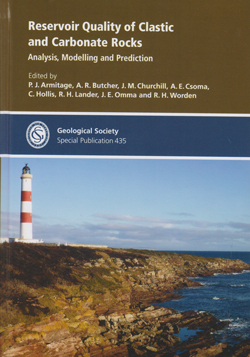
This volume followed the Geological Society of London conference of the same name. The conference and this publication showcase the latest understanding and controversies through discussion and case-study in clastic and carbonate reservoir quality. The opening sentence of the first paper summarizes the importance of this volume for petroleum exploration and reservoir development, stating how reservoir quality is the fundamental control on the economic viability of a petroleum accumulation.
The volume discusses how reservoir quality is studied by almost separate specialist communities, one for clastic rocks and one for carbonate rocks. Yet, these communities utilise a wide range of similar techniques and both benefit from the study of modern analogues. However, it must be noted that modelling approaches are quite different for these two families of rock type.
The opening introductory paper summarizes the significant difference in controls on reservoir quality per sediment type and very clearly states how reservoir quality is controlled by interdependent sedimentary and diagenetic factors that can be bracketed into depositional characteristics, eodiagenesis, mesodiagenesis and telodiagenesis. It is worth reiterating how these factors include the primary make-up of sediments (e.g. high-Mg vs Aragonitic calcite in carbonates and the relative quantities of quartz, feldspars and clays in clastics) and sedimentation (including depositional environment and hinterland conditions), as well as diagenetic (compaction, recrystallization, dissolution, pore water composition, burials depth etc.) processes.
Numerous controversies remain in the study of diagenetic processes that impact reservoir quality. These debates are reviewed, including the difference between chemical compaction and pressure solution features, geochemical flux of material to or from reservoir formations, the impact of hydrocarbon emplacement on the diagenesis of a formation and the long-lived research on digenesis of burial dolomitization.
This collection of papers contains case-study based examples of sandstone and carbonate reservoir quality prediction, including a fascinating paper on how areas of good reservoir quality in The Raytown Limestone of Kansas were created by successive diagenetic events, resulting in the spatial distribution of good reservoir quality being correlated to palaeotopographical and structural highs. An additional case-study based paper looks at the impact of a diverse depositional environment and depositional cyclicity on reservoir quality of the mid-Cretaceous Mishrif Formation, finding that a change in reservoir quality could be systematically interpreted, using porosity logs, within regressive cycles that contained deep-marine to shallower-shelf-margin facies that include rudist shoals.
The volume also presents papers on modern analogues, outcrop analogues, modelling and advanced analytical approaches. I recommend this volume as a source for understanding reservoir quality because of the great topical reviews and plentiful accompanying case-studies.
Reviewed by Simon Kettle
RESERVOIR QUALITY OF CLASTIC AND CARBONATE ROCKS: ANALYSIS, MODELLING AND PREDICTION, by P.J. Armitage, A.R. Butcher, J.M. Churchill, A.E. Csoma, C. Hollis, R.H. Lander, J.E. Omma & R.H. Worden (eds) 2018, 435 pp. ISBN: 9781786201393 (hbk.)
List price: £100.00
Fellow's price: £50.00
W: https://www.geolsoc.org.uk/SP435